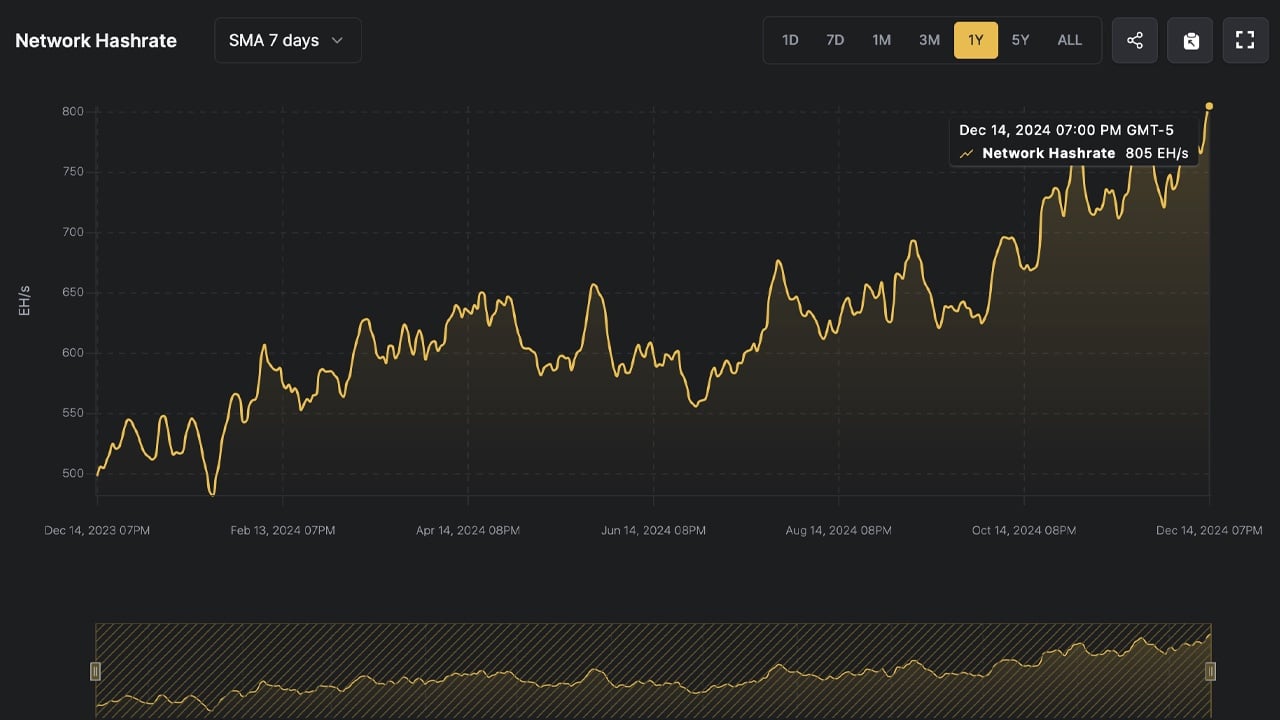According to the latest stats, Bitcoin’s network hashrate has soared past the 800 exahash per second (EH/s) mark, based on the seven-day simple moving average (SMA). The network’s computing might has hit a record-breaking high of 805 EH/s.
Bitcoin Hashrate Hits Record-Breaking 805 EH/s
Over the weekend, bitcoin (BTC) has stayed comfortably above the $100,000 mark, and by Sunday afternoon, it’s been playfully nudging its all-time price high. Alongside these price adventures, Bitcoin’s network hashrate hit a peak of 805 EH/s on Dec. 14, 2024. As of 2:45 p.m. Eastern Time on Dec. 15, the network’s power is cruising at a cool 799 EH/s.

With the network chugging along at 799 EH/s today, let’s rewind a year; it was 293 EH/s less, chilling at 506 EH/s. So, for a fun little comparison, today’s top-of-the-line mining machine can crank out about 473 terahash per second (TH/s), or in EH/s terms, that’s a tiny 0.000473. Now, if every miner theoretically decided to grab just this one type of high-powered machine, you’d need roughly 619,241 of them to boost the network’s hashrate by 293 EH/s we’ve seen this year.
Today, with the network buzzing at 799 EH/s, or just shy of 800, we’re talking eight hundred quintillion hashes per second. With the hashrate so sky-high, block intervals have been zipping by faster than the expected ten minutes, clocking in at an average of 9 minutes 34 seconds. This speediness means that the difficulty retarget, set to happen in just a few hours today, is expected to jump by 4.4%. This increase will make it 4.4% trickier for our mining friends to strike gold with a block.
Given the relentless climb of Bitcoin’s hashrate and BTC’s dance with record prices, we’re witnessing a network that’s not just surviving but thriving with growth. This rise paints a picture of a mining community vibrating with activity, adapting swiftly to new challenges. The future? It looks like more innovation, more competition, and an ever-tightening weave in the fabric of this digital economy. But, can this upward trend sustain itself, or is it destined for a sharp correction in the near future? Only time will tell.
According to the latest stats, Bitcoin’s network hashrate has soared past the 800 exahash per second (EH/s) mark, based on the seven-day simple moving average (SMA). The network’s computing might has hit a record-breaking high of 805 EH/s.
Bitcoin Hashrate Hits Record-Breaking 805 EH/s
Over the weekend, bitcoin (BTC) has stayed comfortably above the $100,000 mark, and by Sunday afternoon, it’s been playfully nudging its all-time price high. Alongside these price adventures, Bitcoin’s network hashrate hit a peak of 805 EH/s on Dec. 14, 2024. As of 2:45 p.m. Eastern Time on Dec. 15, the network’s power is cruising at a cool 799 EH/s.

With the network chugging along at 799 EH/s today, let’s rewind a year; it was 293 EH/s less, chilling at 506 EH/s. So, for a fun little comparison, today’s top-of-the-line mining machine can crank out about 473 terahash per second (TH/s), or in EH/s terms, that’s a tiny 0.000473. Now, if every miner theoretically decided to grab just this one type of high-powered machine, you’d need roughly 619,241 of them to boost the network’s hashrate by 293 EH/s we’ve seen this year.
Today, with the network buzzing at 799 EH/s, or just shy of 800, we’re talking eight hundred quintillion hashes per second. With the hashrate so sky-high, block intervals have been zipping by faster than the expected ten minutes, clocking in at an average of 9 minutes 34 seconds. This speediness means that the difficulty retarget, set to happen in just a few hours today, is expected to jump by 4.4%. This increase will make it 4.4% trickier for our mining friends to strike gold with a block.
Given the relentless climb of Bitcoin’s hashrate and BTC’s dance with record prices, we’re witnessing a network that’s not just surviving but thriving with growth. This rise paints a picture of a mining community vibrating with activity, adapting swiftly to new challenges. The future? It looks like more innovation, more competition, and an ever-tightening weave in the fabric of this digital economy. But, can this upward trend sustain itself, or is it destined for a sharp correction in the near future? Only time will tell.





